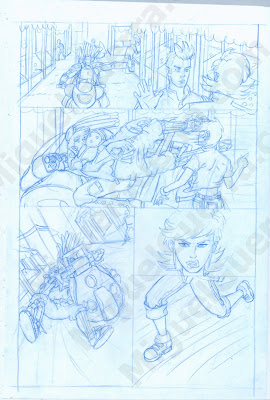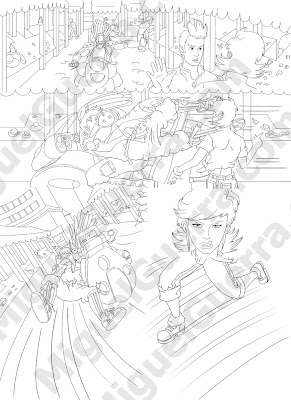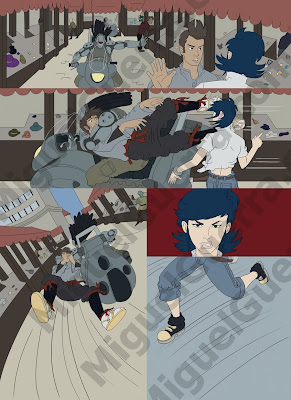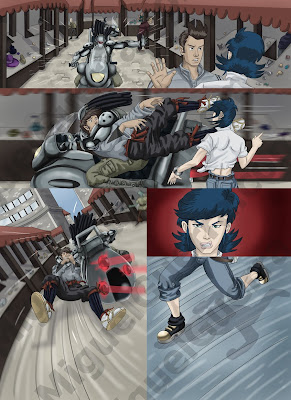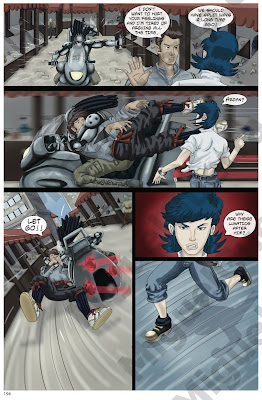So what is digital inking? Until a few years ago, it sounded like a mythological creation like Medusa, the Hydra or Godzilla. By Great Zeus, Manga EX is no figment of someone’s imagination. It’s a fantastic inking program and I can’t say enough about it. It’s now a major part of my process.
Let’s discuss traditional inking. That nostalgic feeling of ink between your fingers; the sharp edge of a crow quill against a fresh sheet of paper; the sound of it as it accidentally cuts through the fiber. The white correcting paint or tape to cover up your mistakes, much like a 13 year old tween blotting all the nicks on his face with tiny pieces of toilet paper as he learns how to shave. Then there’s the drying time and the accidental smears. Ah, the good ol’ days.
Now let’s step into the present. The one thing I never got used to was inking over my pencils. I put a lot of work into those damn drawings and I don’t always want to part with them. Now I get to scan in my pencil illustrations and sketches and keep the originals. Most people don’t mention this, but when you scan in your inks, they’re messy! Even if you do a great job and the inks seem clean to your eye, once you scan them in you see dots and smears everywhere from both the pencils and the inks. The clean up time required when we did
Samurai Elf (vol. 1): Set Apart was insane! Suzy Dias (my co-writer) and I had to use Photoshop to adjust the levels and the brightness/contrast. The catch is that the cleaner you get the white(paper), the more you lose on the black (inks). It added so much time to our process that I was desperate to find something more efficient for volume 2.
Manga EX was like manna from heaven. The precision is fantastic! Instead of using that old magnifying light over your drawing desk, just zoom in - as much as you like. The amount of detail you add is completely up to you. I can get the straightest lines, the curviest ellipses and the roundest French curves for precise perspective, which beats using rulers. Most artists hate using rulers because they’re a pain in the butt. It’s easier to draw freestyle, Manga EX makes inking everything from buildings to cars to high tech devices easy.
Samurai Elf had so many architectural and tech elements that it allowed me to keep things looking more ‘real.’ It’s actually improved my drafting skills.
Here's a step by step look at the inking process, starting with my scanned in pencils through until my finished inks.
What are some of the best features?
Undo My hands down favorite, which beats traditional inking every time.
LayersThe ability to separate my perspective lines from the rest of my inks is a little piece of heaven.
EraseMistakes happen and being able to simply rub out an error is a big relief. Sometimes you simply change your mind about a line. Whatever the case, erase is a thing of beauty for any inker.
ZoomMagnify as much as you want. I’ve been able to add so much detail that I sometimes surprise myself. Traditional inks would never allow for it, especially when you’re dealing with deadlines. Adding complexity to backgrounds and detail to clothing is now more accessible to everyone.
Pencil I use often use the pencil tool when I feel a drawing needs to be reworked. If you combine this with the Zoom tool, you’re off to the races. A tip is to add a layer, decrease the opacity so you can see the original pencils beneath, then make your changes.
SpeedlinesEverything from adding emotion to high speed chases is at your fingertips. Speedlines is what originally attracted me to Manga EX. When I did
Samurai Elf (vol. 1): Set Apart, I wanted to use more speedlines, but didn’t have the tools or the time to learn. I added them using PhotoShop with limited success. I also had a big problem with the black not staying true black.
I did not want to have to deal with that on
Bull’s Eye (vol. 2), especially since it was in colour and I wanted to try using different coloured speedlines. Not only did the speedlines work out, I also discovered how to turn focus lines into contours, which gives rounded objects, like a fist or a foot, that high speed feeling.
Easy to UseI really enjoy the fuss-free and straight forward interface. Anyone at any skill level can easily use this program.
TimeThe amount of time it takes me to ink is slashed in half. And I don’t have to worry about the expense of ink supplies and paper. Just one inexpensive software program does everything.
http://my.smithmicro.com/win/mangaex/




